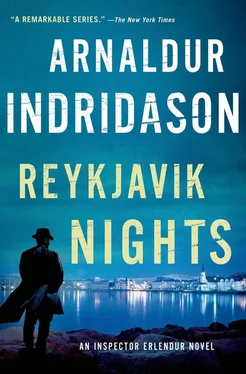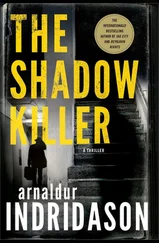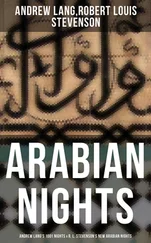Arnaldur Indridason
Reykjavik Nights
There was a green anorak in the water. When prodded, it stirred, turned a slow half circle and sank from view. The boys fished at it with their poles until it floated up to the surface again, then recoiled in horror when they saw what lay beneath.
The three friends lived on Hvassaleiti, in the residential blocks lined up along busy Miklabraut all the way down to the expanse of waste-ground known as Kringlumýri. To the north the waste-ground was overgrown with nettles and angelica; to the south lay a large area of open diggings, deep gashes in the earth, where the inhabitants of Reykjavík had excavated peat by the ton to heat their houses during the First World War when fuel was in short supply. They had drained and laid tracks across the marshy ground before embarking on the largest scale peat extraction in the history of the city. Hundreds of men had been employed in cutting, drying and transporting it to the city in wagons.
After the war, when imports of coal and oil resumed, the abandoned workings gradually filled with brown groundwater and remained like that for many years. Later, in the fifties and sixties, when the city expanded to the east and new suburbs rose on Hvassaleiti and Stóragerdi, the area became a playground for the local children, who built rafts to sail on the largest ponds and wore cycle tracks up and down the various hills and mounds. When the temperature dropped in winter, the icy pools came into their own as skating rinks.
The three boys had knocked up a new raft, using off-cuts of timber from a nearby building site. It consisted of two sturdy crossbars, some sheets of polystyrene and a serviceable platform made of planks from a concrete mould. They propelled it with long poles, which they inserted into the murky water and used to push off from the bottom, since the pool wasn’t very deep. Although they wore rubber boots and did their best to keep dry, it was not uncommon for kids to fall in. Then they would return home with their knees trembling from the cold and at the thought of yet another telling-off — or worse — for turning up like drowned rats again.
They punted along gingerly in the direction of the Kringlumýri road, trying not to rock the raft in case it shipped water or sent them overboard. There was quite a knack to this: like tightrope walking, it required cooperation, skill, and not least a cool head. The boys took their time to find their balance before finally daring to push off from shore, aware that if they stood too close together on one side they risked capsizing.
In the event, the maiden voyage exceeded expectations. They were pleased with their new craft, which slipped along easily, and they made several trips back and forth across the deepest part of the pond. The rumble of traffic reached them from Miklabraut in the north, while the view to the south was dominated by the geothermal-heating pipeline that supplied hot water to the tanks on top of Öskjuhlíd hill. This was another of their playgrounds, where they sometimes came across small, hard balls the size of hens’ eggs. They had puzzled over these until one of their fathers explained that they were golf balls. People must have been practising on the waste-ground by the pipeline, he said, adding that Reykjavík’s golf course had once been located on the eastern side of Öskjuhlíd, not far from Kringlumýri. In those days the area had been known as Golfskálatjörn or ‘Clubhouse Pond’, though he thought it unlikely the balls had been lying there that long.
They were making good headway when the raft encountered an obstacle. One corner dipped into the dark water, and they came to a standstill. The boys quickly restored the equilibrium by shifting to the opposite side, and gradually the platform rose up again, though not all the way. It must have caught on something heavy. On previous excursions they had found a variety of junk in the brown depths; rubbish that had been thrown into the pits, such as the broken bicycle that jutted up in one spot. Some of this junk, like the polystyrene, had come in handy for raft building, but this hindrance, whatever it was, seemed more immovable. They guessed it must have snagged on a nail sticking out of one of the crossbars.
Warily, they tried pushing backwards, and discovered that it took all their strength to move their vessel. The debris dragged along with them a short way, then the raft suddenly broke free, its corner shooting up out of the water, almost causing them to overbalance. They managed to steady it again, thanking their lucky stars that they hadn’t got drenched, then turned their attention to the thing that had been pulled up to the surface.
‘What is it?’ asked one, poking cautiously with his pole.
‘Is it a bag?’ asked his friend.
‘No, it’s an anorak,’ said the third.
The first boy prodded harder, jabbing the object until finally it moved. It sank from view and they fished around until it floated up again. Then, by slow degrees it turned over, and from under the anorak a man’s head appeared, white and bloodless, with colourless strands of hair. It was the most gruesome sight they had ever seen. One of the boys let out a yell and tumbled backwards into the water. At that, the precarious equilibrium was lost and before they knew it all three had fallen overboard, and they waded shrieking to the shore.
They stood there for a moment, wet and shivering, gaping at the green anorak and the side of the face that was exposed above the water, then turned and fled as fast as their legs would carry them.
A report came over the radio about a disturbance at a house in the Bústadir district and they accelerated onto Miklabraut eastbound, then crossed Háaleiti and took Grensásvegur south. It was long gone three in the morning and there was little traffic on the roads, though they passed two taxis heading for the suburbs, before almost colliding with another vehicle which crept up from Fossvogur and into their path at the Bústadavegur junction. The middle-aged man at the wheel had apparently failed to notice how fast the police van was travelling and had judged it safe to pull out.
‘Is he crazy?’ shouted Erlendur as he swerved violently round the vehicle before continuing along the road.
‘Should we pull him over?’ asked Marteinn from the back seat.
‘Leave him,’ said Gardar.
Glancing in the rear-view mirror, Erlendur saw that the car was now crawling west along Bústadavegur.
Gardar and Marteinn were law students temping for the summer. Erlendur quite enjoyed working with them. Both had Beatles haircuts, fringes flopping over their eyes, and large sideburns. At present the three of them were riding in a lumbering police van, a black-and-white Chevrolet, slow but reliable, equipped with a small holding cage for prisoners in the back. They hadn’t bothered to turn on the siren or the flashing lights, which was probably why they’d nearly collided with the car, but they didn’t need to for a domestic incident in the early hours. Sometimes Gardar liked to activate the whole system and drive like a maniac, though, just for the hell of it.
They parked outside the house, put on their white caps and climbed out into the light summer night. Though overcast and drizzling, it was mild. There had been a fair amount of drunkenness in town, but nothing serious until now. Earlier they had stopped a motorist on suspicion of drink-driving and taken him for a blood test. After that they had been summoned to a brawl outside a crowded nightclub, followed by another at a rundown house in the west end, where five men of assorted ages, a ship’s crew from out of town, rented a couple of rooms. A shouting match with their neighbours had ended in blows, in the course of which one of them had pulled a knife and managed to stab another man in the arm before being overpowered. When Erlendur and company arrived to put an end to the fight the man was so enraged he was foaming at the mouth, so they cuffed him and took him to cool off in the detention cells at Hverfisgata. The others had sobered up with the arrival of the police and gave conflicting accounts of how it had all started.
Читать дальше












